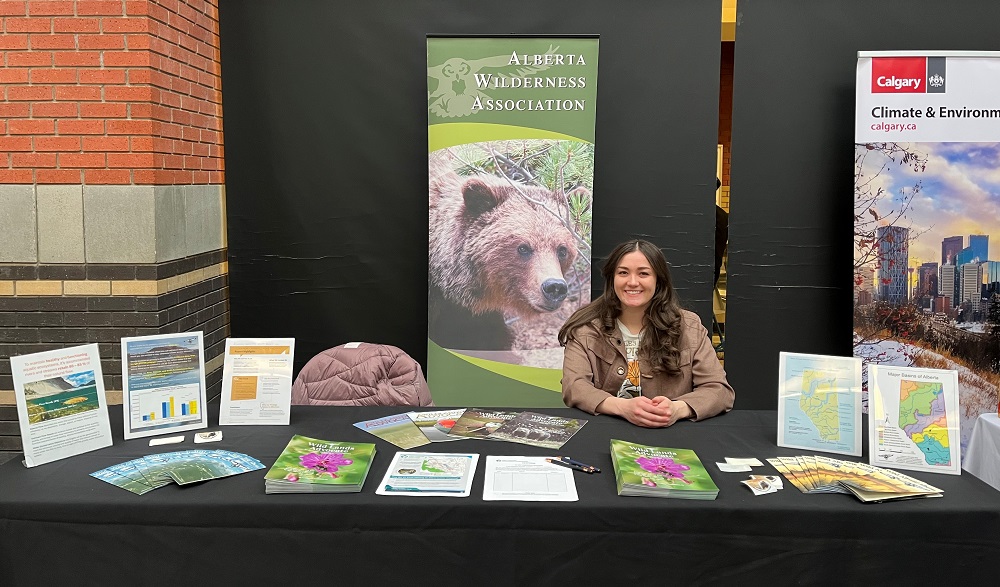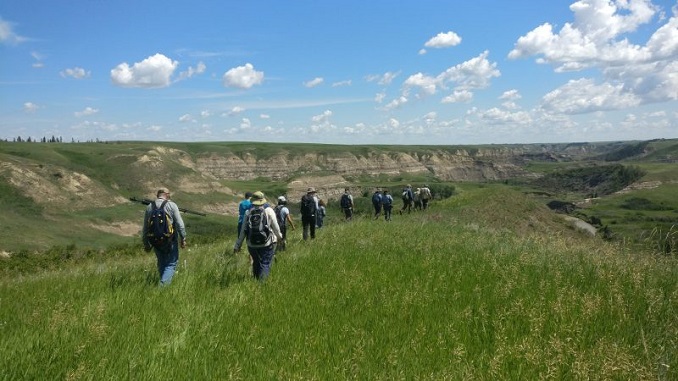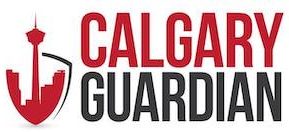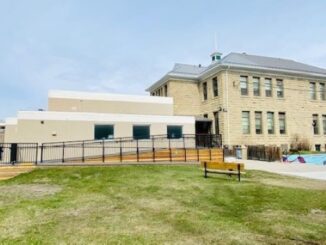The Alberta Wilderness Association (AWA) is a conservation organization dedicated to protecting Alberta’s wildlife, wilderness, and water through advocacy, education, and action. For over 60 years, AWA has worked to preserve ecologically significant areas, promote responsible stewardship, and hold governments and industries accountable for environmental policies.
We spoke with Kennedy Halvorson, Conservation Specialist at AWA, to learn more about the organization’s ongoing efforts to safeguard Alberta’s natural landscapes, the challenges they face, and how the public can get involved in conservation initiatives.

Describe your charity/non-profit/volunteer work in a few sentences.
Alberta Wilderness Association (AWA) began around a kitchen table in 1965. Motivated by the shared recognition that government policies were destroying, not preserving, Alberta’s public lands and wild spaces, a group of backcountry enthusiasts decided it was time to take action. Floyd and Karen Stromstedt, Marian and Bill Michalsky, and Steve and Helen Dixon started speaking out, gaining support from local farmers, teachers, and community leaders who were interested in conserving Alberta’s wildlife and habitat. These efforts paid off; three years later, their numbers had swelled, and in 1968, 34 people came together in Lundbreck to officially form AWA. For over 60 years now, AWA’s mandate has been the same: protecting and promoting good stewardship of Alberta’s wildlife, wilderness, and waters.
What problem does it aim to solve?
AWA’s work focuses on raising public awareness about conservation issues, advocating for better policy and environmental protections, and inspiring action to protect the wild spaces Albertans love, to ensure future generations enjoy the abundant benefits they provide. As an organization, our ultimate goal is to see the establishment of a network of diverse, ecologically representative, and well-managed protected areas throughout the province.
This mandate is well reflected in our history; since AWA’s inception, we’ve helped get new protected areas established in the Castle, Hay-Zama, Milk River, Plateau Mountain, Rumsey, and Wainwright Dunes areas. AWA’s helped increase public engagement and environmental considerations on numerous pieces of important policy, including the 1976 Coal Policy. When advocacy and engagement haven’t worked, AWA’s been able to hold governments accountable through the courts, which has led to the enactment of Canada’s first environmental assessment act in 1992 and secured a critical protection order for the greater sage grouse in 2013.
When did you start/join it?
I began working at AWA in June 2023, but I’m preceded by a long line of dedicated staff and board members, volunteers, friends, and just general supporters of AWA that make our work possible.
What made you want to get involved?
The environmental sector is a bit of a catch-22. Most folks who get into it are similarly motivated – they love nature, they enjoy being outdoors, they’re passionate about plants or animals, they’re worried about global crises like climate change and biodiversity loss. So, it’s a tough reality when, more often than not, the environmental work that’s out there is focused on minimizing pollution, degradation, and destruction, rather than preventing it in the first place. I knew I’d be demoralized if my work amounted to flagging nests before they clear-cut a forest, or surveying a wetland prior to draining it for development. I wanted to do work where I could advocate for something better.
Luckily, if you really look for it, there are great environmental jobs out there, particularly at non-profits. AWA was a natural fit – it’s a small team of passionate people, with a lot of generational knowledge and accomplishments to draw from and aspire to.
What was the situation like when you started?
In terms of AWA’s conservation work, our efforts are typically focused on areas or species of concern. AWA’s areas of concern are places in the province where the environment is still relatively intact and wild, where increased protections would benefit both wildlife and human populations. Species of concern are animals in the province that reflect the health of their respective habitats. So, for example, looking at woodland caribou is useful for understanding the state of Alberta’s boreal forests; native trout populations tell us a lot about the well-being of our watersheds. Grizzlies’ rep the Rockies, and greater sage grouse the grasslands. These species act as indicators – if their populations are threatened, we know that the ecosystems in which they reside are similarly at risk.
When something threatens either an area or species of concern, AWA waves the warning flags. When I began, AWA was waving those flags to protect places like the Bighorn, Frank Lake, and the Upper Highwood from unsustainable development and use. We were worried for greater gage grouse again, as despite the critical protection order, governments were still approving nearby developments that were causing population decline. AWA was requesting free-ranging bison be designated as wildlife instead of livestock, because, as livestock, they are not protected outside of a few specific areas, hindering both reintroduction and reconciliation efforts.
One of the major campaigns underway was an effort to prevent the destruction of the McClelland Lake Wetland Complex. Located 90 km north of Fort McMurray, this area acts like the region’s kidneys; it helps filter and clean water and recharges surface and underground water supplies. This complex is larger than 91% of all other wetlands in Alberta and has socio-cultural importance for nearby Indigenous communities. It’s an important stopover point and breeding ground for migratory bird species from across North America. It contains rare features, including a patterned fen formed by long rows of peat ridges separated by shallow pools of water, surface patterns that have taken thousands of years to develop. They give the fen a unique and spectacular beauty; they also store a large an immense amount of carbon, with peat deposits up to eight metres deep in some places. Yet, Alberta was set to allow Suncor to mine half of it.
When the permits were first issued, it was with the restriction that mining could only occur so long as the ecological diversity and functionality of the unmined portion were maintained. After reviewing Suncor’s proposed plan to protect what would remain of McClelland, AWA contracted experts and prepared a report, asking the Alberta Energy Regulator (AER) to reconsider their initial approvals, as we’d found Suncor’s plan could not guarantee the ecological integrity of the wetland.

How has it changed since?
Progress in this field can be frustratingly slow – many of these issues take years to address, and wins are often hard-fought, small, and incremental. For example, it is meaningful that the logging in the Upper Highwood was even paused, as it gave time for the company to consult with the community and consider concerns. It was an achievement that Frank Lake was determined to be an inappropriate place for a solar development, due to its global significance as habitat for waterfowl. It’s notable that AWA’s report on McClelland convinced the AER to reconsider their approvals for Suncor’s Plan, and although they ultimately decided to let the project go ahead, it proved that submitting scientific reports directly to the regulator is a potential avenue for getting better environmental considerations.
To be frank, I’ve seen a lot of bad policy changes and initiatives introduced by government since I began working at AWA; the slew of new regulations just for hunting and trapping is overwhelming. Despite being a threatened species with a recovery plan, grizzly bears can now be hunted by anyone over 18 with a hunting license and permit, if they are deemed a ‘problem’. There is now no limit on the number of fishers, lynx, river otters, and wolverines that can be trapped, despite indications their populations are low and insufficient to support additional pressures. The number of female cougars that can be hunted has suddenly doubled. They’ve expanded where people could hunt and trap, including into several provincial parks where wildlife is supposed to be protected. Public consultation leading up to these changes was completely absent and the new regulations are not backed by the government’s own research. They have no basis in current best wildlife management practises, and the province has been unwilling to provide any data or findings justifying their decisions. This threatens already at-risk species in Alberta, which in turn risks the integrity and function of Alberta’s ecosystems and all the benefits they provide.
This is indicative of what we’re seeing a lot of right now: rapidly introduced and sweeping changes, without proper due diligence, evidence, or consultation, that do not seem to be in the best interest of Albertans or the environment. It makes AWA’s work all the more important, so we will continue to notify the public of these changes through the news, social media, and events, to explain their implications and consequences through an environmental lens, to put pressure on the government and industry to hold them accountable.
What more needs to be done?
AWA can raise the alarms, but our work is only as powerful as the public’s ability to answer. We need everyday Albertans need to speak up and demand the government do better, to protect and manage Alberta’s ecosystems and species as if the province’s wellbeing depended on it – because it does!
How can our readers help?
There’s a number of ways you can support our work, whether that’s through donating, becoming a member, attending our events, joining our newsletter, following us on social media, sharing our work, volunteering, signing petitions, and contacting your elected officials to ensure they know the environment is a priority to you – any capacity you have to help is appreciated!
Do you have any events coming up?
Celebrate AWA’s 60th anniversary with our What’s Your 60? Challenge
Where can we follow you?
Website | Facebook | Instagram | LinkedIn | YouTube
PAY IT FORWARD: What is an awesome local charity that you love?
Alpha House Society. They do incredibly necessary and important work helping Calgary’s most vulnerable populations, dispelling harmful myths and misconceptions, and delivering information, resources, and care in ways that are evidence-based and compassionate.




